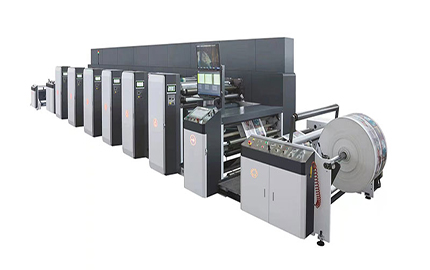Datatime: 2024-11-08 15:15
Visit: 140
A flexo printing machine, also known as a flexographic printing press, is a type of printing equipment that uses a flexible relief plate for printing.

The process is based on the use of a flexible printing plate. The plate has a raised image area that transfers ink to the substrate. Ink is applied to the plate using an anilox roller. The anilox roller is a precision - engineered roller with a large number of tiny cells engraved on its surface. These cells hold the ink and transfer it to the raised areas of the flexible printing plate.
When the substrate (such as paper, plastic film, label stock, etc.) passes between the printing plate and an impression cylinder, the ink on the raised areas of the plate is transferred onto the substrate, creating the printed image.
Printing Plate Cylinder: Holds the flexible printing plate. The plate is usually made of rubber or photopolymer material. Photopolymer plates are more commonly used nowadays due to their better resolution and durability. The diameter of the printing plate cylinder can vary depending on the machine design and the specific printing requirements.
Anilox Roller: As mentioned earlier, this roller is crucial for ink transfer. The cells on the anilox roller are designed to accurately meter and transfer a specific volume of ink to the printing plate. Different cell volumes are available for different ink viscosities and printing requirements.
Impression Cylinder: This cylinder provides the pressure needed to transfer the ink from the printing plate to the substrate. It presses the substrate against the printing plate to ensure good contact and ink transfer.
Ink System: Consists of ink tanks, pumps, and a series of pipes and valves to supply ink to the anilox roller. The ink system can handle different types of inks, such as water - based inks, solvent - based inks, or UV - cured inks.
Drying System: Since inks need to dry quickly to prevent smudging and ensure a high - quality print, flexo printing machines are equipped with drying systems. For water - based inks, hot - air drying systems are often used. For UV - cured inks, UV lamps are used to instantly cure the ink through a photochemical reaction.
Versatility: Can print on a wide variety of substrates including papers, plastics, films, and non - woven materials. It is suitable for packaging materials such as corrugated boxes, flexible packaging, labels, and more.
Cost - effectiveness: The printing plates are relatively inexpensive compared to plates used in other printing methods like offset printing. This makes it a cost - effective option for medium - to - large - scale printing jobs.
High - speed Printing: Capable of high - speed production, making it ideal for large - volume printing. Some advanced flexo printing machines can print at speeds of several hundred meters per minute.
Environment - friendly: When using water - based inks, flexo printing has a lower environmental impact as it reduces the emission of volatile organic compounds (VOCs) compared to solvent - based inks.
Print Quality: While modern flexo printing machines can produce high - quality prints, in general, the print resolution may not be as high as that of offset or gravure printing for extremely fine details. However, continuous improvements in plate materials and printing technologies are narrowing this gap.
Plate Wear: The flexible printing plates can wear out over time, especially when printing on rough substrates or with high - volume jobs. Plate wear can affect print quality and requires regular plate replacement to maintain consistent results.
In conclusion, the flexo printing machine is a highly adaptable and efficient printing solution. Its advantages in terms of versatility, cost - effectiveness, and high - speed production make it a popular choice across many industries, especially packaging. While it has some limitations in print quality and plate durability, continuous technological advancements are helping to overcome these challenges, ensuring that flexo printing remains a relevant and important printing method in the future.

Feb 11,2025
Full Servo Horizontal Flexo Printing Machine represents a significant leap forward in printing technology. Its combinati...

Jan 02,2025
Vinegar is unlikely to "go through" a regular paper cup under normal circumstances, but there are some factors that coul...

Dec 11,2024
Paper cups have become an ubiquitous part of our daily lives, serving as a convenient and hygienic way to consume bevera...
GET A QUOTE